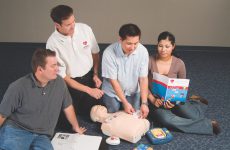
It’s likely you have already heard about anaphylaxis and the life-threatening effects it can have on an individual. But can you confidently say you would know how to administer care to someone suffering from an anaphylaxis emergency?
Whether you know someone who can suffer from an anaphylaxis reaction, everyone should be prepared and educated in case of an emergency. Your quick thinking, actions and treatment could just save someone’s life!
What is anaphylaxis?
Before you learn how to be prepared for an anaphylaxis emergency, you need to first understand what it is. Anaphylaxis is the most severe form of an allergic reaction that if not treated immediately, can quickly become life-threatening. Usually occurring within 20 minutes to two hours from exposure to an allergen, anaphylaxis requires urgent medical attention. Often affecting more than one body system, it can cause many life threatening symptoms without preventative measures in place.
Now that you understand what anaphylaxis is and its severity, here are three ways you can be equipped to handle the allergic reaction in an emergency.
1. Know what can trigger an anaphylaxis reaction
Anaphylaxis can be triggered by a range of allergens which vary from person to person. From food to stings, medication and even bites, anaphylaxis can be activated from a range of sources. In some cases, even just the smell of the allergen can result in an individual having an anaphylaxis reaction. Some common allergens include:
- Food (milk, eggs, peanuts, tree nuts, sesame, fish, shellfish, wheat and soy)
- Venom from bites and stings (bee, wasp and ants)
- Medications
- Other (latex, exercise or non-identifiable causes)
If you know someone who can suffer from an anaphylactic reaction, it’s critical you remove the allergen from their everyday life. This will help reduce the likelihood of an anaphylactic reaction occurring.
2. Know what the symptoms are
Similarly to anaphylactic allergens, symptoms can be extremely varied from one person to another. Individuals experiencing anaphylaxis can have both subtle and life-threatening symptoms, within minutes of being exposed to their allergen. Some of these symptoms can include:
- Skin reactions (hives, itching, rashes, flushed or pale skin)
- Low blood pressure
- Difficulty breathing caused by a constriction of airways (swollen tongue or throat)
- A weak or rapid pulse
- Nausea, abdominal pain, vomiting or diarrhoea
- Dizziness, fainting or unconsciousness
- Wheezing or a persistent cough
Although some of these symptoms are less threatening than others, all anaphylaxis cases should be treated as an emergency. Symptoms can quickly escalate and become life-threatening so it’s imperative that patients are treated as soon as possible by a professional.
3. Know how to treat an anaphylaxis patient
While there is no cure, people who are prone to anaphylaxis should be carrying an EpiPen in case of an emergency. These auto-injectors contain adrenaline which will help reduce the patient’s symptoms. Although EpiPens are designed to be used by everyone, it’s recommended to receive training so you know how to administer the treatment correctly. It’s very common for people to accidentally inject themselves with the treatment, rather than the patient.
In some cases, the anaphylaxis patient’s heart might stop beating or they might even stop breathing. Therefore, cardiopulmonary resuscitation (CPR) will need to be initiated to restart the heart and increase airflow around the body.
Regardless of the situation or whether you have administered an EpiPen, you should always contact emergency services as soon as possible so the patient can be assessed by medical professionals.
Learn how to be more prepared and properly treat an anaphylaxis emergency by taking an Emergency First Response Course.



